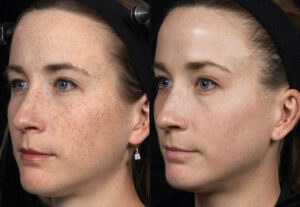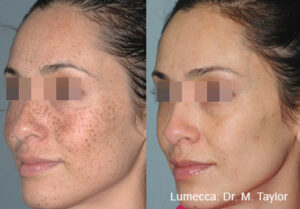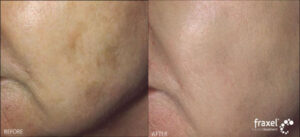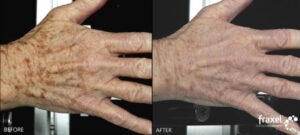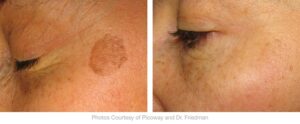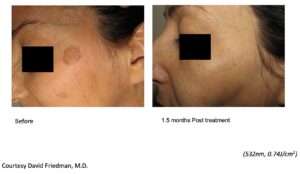Aesthetic Concerns
With the latest advances in dermatological care, medical aesthetics, and skin rejuvenation, the most frequently reported aesthetic concerns can be significantly improved or even reversed. At Dermatology Consulting we have invested in the most advanced equipment and treatment techniques to address these concerns safely, effectively, and with natural-looking results.
Explore Topics
Thread Veins, Facial Redness, and Flushing
Thread veins (sometimes referred to as spider veins) are normal skin blood vessels that have become permanently enlarged so that they are visible.
Thread veins on the face are usually due to sun-damage or rosacea. Thread veins/spider veins on the legs often arise in association with varicose veins, although they can occur spontaneously without a background of varicose veins.
They are harmless and usually cause no symptoms, but patients can be self conscious about their appearance. When they occur on the face as part of rosacea there may be some associated flushing and “burning sensation” of the skin. When they occur on the legs, if there is thought to be some associated problems with the rest of the leg vein system, we may arrange ultrasound scans of the leg vein system to check for any leaking valves that could be contributing to the leg thread veins.
Treatments
- Pulsed Dye Laser: With gentle settings no recovery time. With higher settings temporary bruising
- Long Pulsed NdYag Laser within either the Excel V+. Fotona SpDynamis, or Cynergy Laser: With gentle settings no recovery time. With higher settings temporary bruising
- KTP Laser within the Excel V+: With gentle settings pinkness and slight swelling for a few days. With higher settings slight bruising and moderate swelling for a few days
- Intense Pulse Light by Lumecca: Usually no recovery time, although co-existing freckles and brown spots will become slightly darker and fade.
Brown Spots
Brown spots on the skin can be frustrating and can make the skin look blemished and aged.
The commonest type of individual brown spots are solar lentigos (often described by patients ‘sun spots’ or ‘liver spots’) and occur as a result of sun exposure and ageing. Other causes of brown spots include freckles, moles, solar keratoses (scaly, precancerous areas of sun damage), seborrhoeic keratoses (harmless areas of thickened skin which are usually raised and slightly waxy in texture) or following inflammation such as acne or eczema (called post inflammatory hyperpigmentation). More rarely brown spots can be a form of birthmark. More diffuse increased pigmentation can be due to melasma or post inflammatory hyperpigmentation.
It is always important to have an accurate diagnosis of an area of changing pigmentation by a dermatologist before any treatment, to make sure an area of potential skin cancer is not missed. This is because brown spots that are irregular in their pigmentation pattern and shape can very occasionally be due to a form of skin cancer called melanoma, so it is important that the correct diagnosis of a brown spot is made by a qualified practitioner with dermatology training.
At your consultation your dermatologist will assess and correctly diagnose your pigmentation problem and develop an individual treatment program to deal with your specific problem.
What treatment options are available for brown spots?
A variety of treatment options are available according to the individual pigment problem, including sun blocks, specialised skin care products, prescription vitamin A creams (retinoids), prescription lightening creams, glycolic acid products, chemical peels, microdermabrasion, hydrafacials, cryotherapy/ freezing (using liquid nitrogen), microneedling and lasers. The most dramatic and rapid improvement is achieved with the PicoWay® laser, Intense Pulsed Light or Fraxel® lasers, in particular the Fraxel® Restore laser with Dual wavelengths (1550nm and 1927nm).
Fraxel® Restore Laser with Dual Wavelengths (1550nm and 1927nm)
Fraxel® laser technology was patented at Harvard University in 2003. Fraxel lasers use microscopically small beams of laser energy to precisely treat 15-50% of the skin at a time. The islands of treated skin stimulate the body’s own natural healing to produce new fresh skin and push the unwanted pigment and old collagen out, replacing it with younger-looking, clear skin.
The Fraxel® Re:store with Dual Wavelength has both 1550nm and 1927nm wavelengths and is non-ablative i.e. it does not break the surface of the skin and therefore has a short recovery time. It removes both pigment and old collagen so it also helps rejuvenate the skin texture, reduce wrinkles, tighten pores and soften scars as well as removing unwanted pigment. Both the 1550nm and 1927nm wavelength are good for pigment and texture, but the 1927nm is particularly good for pigment. After the treatment the skin may be red and slightly swollen and there is usually slight flaking of the skin 5 -10 days later. As the skin is not broken, patients are usually able to return to work that day and are able to wash and apply make-up as usual (although they would not choose to go to a big event that day). The treatment is performed using local anaesthetic cream. Patients see an improvement after one session but most choose to have 3-6 sessions for maximum results. Because the Fraxel® treatment does not break the skin it is safe and effective on delicate parts of the body such as the neck, chest, hands and arms as well as the face. It can also be used on skin of all colour (from very fair to very dark).
A particularly popular treatment is to have the 1927nm wavelength treatment first to remove the unwanted pigment, then follow it up 2-4 weeks later with the 1550nm wavelength to help reduce wrinkles and improve skin texture. Another popular choice is to do both the 1550nm and 1927nm treatment on the same day.
For melasma, a very effective treatment is to combine the Picoway Laser with a couple of gentle passes with the Fraxel 1927nm, a treatment we refer to as “Clear and Lighten”.
Intense Pulsed Light (Lumecca)
Intense Pulsed Light (Lumecca) is also effective for treating large areas of sun-damage by improving both redness and sunspots at the same time. Following treatment the brown spots develop a slightly darker crust which scabs away over a few days and the redness looks less prominent. There is no swelling. However, Intense Pulsed Light Treatment should not be performed if there is a tan.
PicoWay® Laser
The PicoWay® lasers are excellent at removing unwanted pigmentation, including sunspots, birthmarks and post-inflammatory hyper-pigmentation. In fact, the PicoWay® is able to remove pigmentation in such a gentle way that it has also been FDA-approved to improve melasma/chloasma. It is one of only a handful of laser devices (of which Fraxel® Restore is another) which is FDA-approved for improving melasma.
When the PicoWay® is used for pigmented skin lesions, it feels like a very short, warm (but not painful) spark on the treated skin and the brown marks go slightly darker. There may be some very slight swelling of the brown mark, which settles within a day or two. The slight darkening of the brown marks lasts 10-20 days while the body’s own clearance system clears the pigment away. Some brown skin lesions clear in one session, but most need 2-3 sessions to clear. Individual brown spots can be treated by using 2-4 mm diameter beams to trace over the surface of the individual brown spot or, for larger areas, a 6mm fractionated spot can be used to pass over the large area. It does not usually require local anaesthetic cream.
As mentioned above, for melasma, a very effective treatment is to combine the Picoway Laser with a couple of gentle passes with the Fraxel 1927nm, a treatment we refer to as “Clear and Lighten”.
All of these treatments for skin pigmentation should be done alongside good sun protection and good skin care, including sometimes prescription products which our consultant dermatologists can advise you about.
Irregular Pigmentation and Melasma
Uneven areas of increased pigmentation (called hyperpigmentation) can leave skin looking dull, blotchy, or aged and can be very distressing. The commonest causes for this are melasma and pigmentation occurring after some form of inflammation (such as acne or eczema or friction) called post-inflammatory hyperpigmentation. There are also some rarer causes which can be recognised by dermatologists such as hormonal causes or certain forms of birthmark.
The first step is an accurate and correct diagnosis of the type of hyperpigmentation.
Melasma
Melasma causes diffuse patches of increased pigmentation on the face, It tends to occur in individuals who tan easily (i.e. those with Mediterranean, Asian or African heritage). It is now known to be an inflammatory process and it worsened by many triggers including sun exposure, irritation of the skin, friction, heat and oestrogens (for example the contraceptive pill or pregnancy). If one is prone to melasma it is an on-going condition, and if one does not do the right steps to maintain and prevent it, the melasma will recur. However, at Dermatology Consulting, as consultant dermatologists we are expert at treating melasma and have strategies and treatments to bring it under control and manage it.
Post Inflammatory Hyperpigmentation (PIH)
Post inflammatory hyperpigmentation (PIH) occurs in individuals who tan easily. Possible trigger include acne, rashes such as eczema, friction, surgery, heat and some forms of laser. It can occur on any site of the body.
Treatment Options
Personalised Skin Care
Our consultant dermatologists and their team of experienced nurses and laser therapists can recommend skincare that helps reduce and prevent the excess pigmentation.
The most essential of the skincare in good sun and visible light protection. It is now known that the significant worsening of melasma that occurs from sunlight is not just due to ultraviolet light but is a also due to visible light so it is essential that individuals prone to melasma practice excellent sun protection including wearing sunscreen that protect against UVB, UVA and visible light (which are usually tinted sunscreen as the iron oxide in the tint protects against visible light). We can recommend a range of excellent sunscreen protecting against ultraviolet and visible light. For optimal protection these should be worn throughout the year and reapplied every couple of hours if you are in the sun. Other important measures include seeking the shade on hot days and wearing a good quality sun protecting hat (again we can advise some good brands). Unless there is optimal protection against ultraviolet and visible light, the melasma or excess pigmentation will never come under control, so this is always the most important step.
We can also recommend daily and night cosmetic skin care products which have some effect on reducing and preventing pigmentation and we have these available to buy in our clinic or online shop. There are now known to be many chemical pathways in the skin that contribute to the production of pigment so there are an increasing number of skin care products now available that can reduce and prevent pigmentation and our consultant dermatologists can advise you on these.
In addition, for more severe cases our consultant dermatologists can prescribe treatment creams which reduce pigmentation. These prescription creams often work more quickly than cosmetic skin care products but they need to be supervised by a dermatologist (as excessive use can cause irritation or even increase in pigmentation).
Hydrafacial
Hydrafacials can be used to gently exfoliate the skin and introduce specific products into the skin such as Vitamin C that can help reduce pigmentation. They are not as powerful as lasers, but they are a popular treatment with no recovery time that can be beneficial alongside the good skin care, and they can be done alongside other treatments such as lasers.
Prescription Tranexamic Acid Tablets.
It is now well established that a prescription product called Tranexamic acid, when taken for several weeks can steadily reduce the pigmentation of melasma. Tranexamic acid is usually prescribed to reduced excess bleeding, but it has a mild anti-inflammatory effect on some of the chemical changes in the skin that are contributing to melasma. It has been shown in several good scientific studies throughout the world to help reduce pigmentation in difficult cases of melasma and excess pigmentation.
It is usually given for a maximum of three months at a time. It is essential to do good protection against sun and visible light for this to work optimally.
As Tranexamic acid makes the blood slightly more sticky (which is why it was originally used to treat bleeding disorders) it should not be used if there is a personal or family history of blood clots (e.g. deep vein thrombosis or pulmonary embolus).
Laser Treatments
Melasma and skin prone to PIH must be treated very carefully with lasers because, if treatments are used that produce too much heat or irritation on the skin these will make the melasma or PIH worse. However at Dermatology Consulting Dr Farrell has many years of experience in using lasers and we have some of the most sophisticated and advanced lasers available, so we are able to use lasers very gently, precisely and safely to reduce excess pigmentation including melasma.
At Dermatology Consulting we use three different lasers for melasma and excess pigmentation.
- Picoway Laser. This superfast laser has beams which are a thrillionth of a second. Because this laser is so fast it puts very little heat into the skin and produces a cool “shockwave” without heat which breaks up the unwanted pigment into tiny particles. The body’s own natural healing process (using natural clearing cells called macrophages) is able to clear these tiny particles of pigment from the skin, whereas before they were too large for the body to remove. It is a comfortable treatment which does not require local anaesthetic and there is no recovery time. It is best done every 4-6 weeks.
- Fraxel 1927nm wavelength. The 1927nm wavelength of the Fraxel Dual laser is particularly good at removing excess pigment from the skin. However, in patients with melasma it is important that very gentle settings with low energy, low density and only a couple of passes are used. This way the excellent pigment removal properties of the 1927nm wavelength is used without causing too much heat or irritation (which would make the pigmentation worse).After the gentle Fraxel 1927nm treatment there may be slight pinkness and flaking of the skin for 2-5 days but individuals do not need any specific aftercare (apart from continuing with their good sunblocks) and they can continue their usual daily activities. With the very gentle settings used for this version of Fraxel 1927nm, some individuals feel they do not local anaesthetic cream, although we can provide local anaesthetic cream for those wish to have it.
- Lasergenesis. In many individuals with melasma there is also inflammation under the skin contributing to the melasma which results in slightly dilated blood vessels. This can give the skin a slightly pink appearance under the melasma and these diluted blood vessels can be seen more easily with the Visia imaging we offer here in the clinic. If there are signs of inflammation and dilated blood vessels under the skin then the gentle Lasergenesis treatment using the 1064nm wavelength can remove the dilated blood vessels and so help the melasma. This is a gentle treatment with no recovery time and it does not require local anaesthetic cream.
Many of these laser treatments work best in combination and a particularly popular combination is Picoway followed on the same day by the gentle setting of Fraxel 1927nm, which we call the “Clear and Lighten” Treatment.
Melasma Treatment Plan and Supervision
Melasma is a complicated problem which is why we always recommend an initial consultation, ideally with one of the consultant dermatologists with an interest in melasma. A bespoke plan can then be put together taking into account your skin type, personal circumstances, time targets and budget. As melasma is an ongoing condition it is sometime necessary to have follow-up or review consultations to asses your progess and to ensure the optimal treatment is being used for your case.
Our appointment team will be delighted to assist you in arranging a consultation.
Fine Lines, Wrinkles, and Irregular Texture
Fine lines, creases and wrinkles are a natural result of ageing and repeated sun exposure, but they don’t have to be permanent. Over time, collagen and elastin break down, slower collagen and elastin production and facial movement create folds and fine lines that can make the skin look tired and aged.
For fine lines and wrinkles worsened by excessive movement one can use neuromodulating injections. This can be done in a subtle way to soften excessive movement but avoiding the “frozen look”.
The structural fine lines and wrinkles can be repaired by several different options including HydraFacial® or PicoWay® Laser (gentle treatments with no recovery), Microneedling (with 24 hours of pinpoint bleeding and redness), Fraxel® Restore (with 5-10 days of pinkness, swelling and flaking) and UltraPulse® Alpha by Lumenis (with pin point bleeding for 1-2 days and significant redness and scabbing for between 3-14 days). As a rough comparison of effectiveness we find that:
- 10 HydraFacial® sessions give similar results to one Fraxel Restore
- 3 Picoway sessions give similar results to one Fraxel Restore session,
- 4-6 Microneedling sessions give similar result to one Fraxel Restore
- 8-10 Fraxel Restore sessions give similar results to one Ultrapulse Alpha.
The best results often come from a series of repeated treatments and these can be a combination of the different treatments listed above done on separate days.
Our consultant dermatologists can give you a bespoke treatment plan to address your fine lines, wrinkles and irregular texture.
Treatments
- Neuromodulators: Minimally invasive, no recovery time, can be done with a tan, usually no need for local anaesthetic cream.
- Fillers: Minimally invasive, but possibly some bruising , can be done with a tan, usually no need for local anaesthetic cream.
- HydraFacial®: Gentle treatment with no recovery, can be done with a tan, no need for local anaesthetic cream.
- PicoWay® Laser: Gentle treatment with no recovery, can be done with a tan, no need for local anaesthetic cream.
- Microneedling: 24 hours of pinpoint bleeding and redness can be done with a tan, needs local anaesthetic cream.
- Fraxel® Restore: 5-10 days of pinkness, swelling, and flaking, avoid doing if there is a tan, needs local anaesthetic cream.
- UltraPulse® Alpha by Lumenis: Pin-point bleeding for 1-2 days, significant redness and scabbing for 3-14 days can be done with a tan, needs local anaesthetic cream.
Sagging and Skin Laxity
One of the most common complaints we hear from clients concerned about the ageing of their skin is “sagging.” As we age, the rate of new collagen and elastin production reduces. Furthermore, excessive sun exposure breaks down the existing collagen and elastin. In certain areas, particularly the face, there is loss of volume of the underlying fat compartments and bone. All of these factors contribute to the development of looser skin and the appearance of “sagging.”
Although excessively loose skin can be removed through plastic surgery, for many people this is too extreme and results in surgical scars that can be worse than the original problem.
Fortunately, new technology is now available which tightens the skin without any recovery time. At Dermatology Consulting we have two of the best skin tightening devices available which tighten the skin in slightly different ways: Sofwave (which uses ultrasound) and Fotona SP Dynamis (which uses laser). These devices deliver heat under the skin to tighten the existing collagen bundles and to stimulate production of new collagen. As these devices deliver the heat under the skin but do not affect the surface of the skin, this means that they have no recovery time and can be done as a ”lunch-time” procedure.
- Sofwave™ Skin Tightening using microfocused ultrasound: No recovery time. Full effects are seen at 6-9 months. For individuals needing more significant tightening a second treatment can be done one month after the first and then every 6-9 months.
- Fotona SpDynamis®: Uses a variety of settings of erbium and/or long pulsed NdYag laser to tighten the skin, usually with no recovery time or very slight pinkness and flaking. Usually best done as a series of 6 treatments every 4 weeks.
Sometimes clients see an immediate tightening result, but the full tightening effect occurs 3-6 months later. These treatments can be done separately or together. Done repeatedly, they usually result in gradual tightening of the skin. Our general impression is that Sofwave produces more noticeable results in overall tightening than Fotona SpDynamis with one treatment, but the results can take 6-9 months to be visible, whereas Fotona SpDynamis gives more rapid results, particularly on thin skin such as the skin around the eyes. Our experience suggests that the best results may come from combining both technologies starting with Ultrapulse then following it up with the Fotona SpDynamis if needed.
Eyes (Including Dark Circles Under Lower Eyelids)
Sometimes referred to as “the window of the soul” our eyes are one of first things other people notice about our face. The thin skin around the eyes is particularly prone to the effects of the environment, volume loss and age resulting in a combination of aesthetic concerns including:
- Fine lines and wrinkles from excessive movement of underlying muscles combined with sun damage and aging
- Sagging and laxity
- Increased pigmentation including dark circles under the eyes
- Thread veins
- Loss of supporting soft tissue volume resulting in shadows and tear troughs.
Treatments available including the following:
-
- For fine lines and wrinkle one can use neuromodulating injections to reduce excessive movement that result in excessive lines and creases. This can be done in a subtle way to soften excessive movement but avoiding the “frozen look”.
The structural fine lines and wrinkles can be repaired by several different options including Hydrafacial or Picoway (gentle treatments with no recovery), Microneedling (with 24 hours of pinpoint bleeding and redness), Fraxel Restore (with 5-10 days of pinkness, swelling and flaking) and Ultrapulse Alpha by Lumenis (with pin point bleeding for 1-2 days and significant redness and scabbing for between 3-14 days). As a rough comparison of effectiveness we find that:
-
-
- 10 Hydrafacial sessions give similar results to one Fraxel Restore
- 3 Picoway sessions give similar results to one Fraxel Restore session,
- 4-6 Microneedling sessions give similar result to one Fraxel Restore
- 8-10 Fraxel Restore sessions give similar results to one Ultrapulse Alpha.
-
The best results often come from a series of repeated treatments and these can be a combination of the different treatments listed above done on separate days.
- Sagging and Laxity can be treated with Sofwave (with no recovery time) or Fotona Smooth Eyes (ranging from no recovery time at low settings to 7-10 days of slight pinkness, swelling and flaking at higher sessions).
- Increased pigmentation and dark circles can be treated with creams including prescription creams, Pulsed Dye laser (with no recovery time), Picoway laser (with little or no recovery time) or Fraxel Restore with 1927 (with 5-10 days of pinkness, swelling and flaking). Several sessions of these lasers are usually needed and combinations of these treatments can be done on the same day or different days. For laser treatment special eye protecting shields will be used, either over the eyes or as protective contact lenses.
- Thread veins can be treated with pulsed dye laser, or KTP laser or long pulsed NdYag laser. Special eye protecting shields will be used, either over the eyes or as protective contact lenses.
- Loss of supporting soft tissue volume resulting in shadows and tear troughs can be treated with tightening devices and fillers.
- For patients with very prominent excessive skin around the eyes this can be removed by blepharoplasty performed by a plastic surgeon.
Often the best results come from a combination of these treatments. Our consultant dermatologists can give you a bespoke treatment plan to deal with your specific concern about your eyes.
Hands
While many people focus on facial rejuvenation, the hands are one of the first places to show signs of ageing. Volume loss, wrinkles , brown spots and prominent veins can all make hands appear older than they are. Treatments such as dermal fillers and laser therapy can dramatically remove brown spots and improve texture , restoring a full, elegant appearance to the hands.
Treatments
A combination of treatments usually provides the best result. These include professional skin care products, including retinoids and antioxidants to improve texture, fillers to restore youthful fullness, and lasers to remove excessive pigmentation and improve tightness and skin texture.
- Fillers such as Profhilo® containing hyaluronic acid, a naturally-occurring lubricant found in the skin and joints, provide volume and hydration. There will be small bumps lasting 24 hours and very occasionally bruising.
- Radiesse®, a filler comprised of Calcium Hydroxylapatite microspheres, can stimulate collagen production within the skin and thereby remodel the dermis for plumpness and restored volume. It is usually introduced using a cannula to reduce bruising.
- Laser technology, including the Fraxel® Re:store with Dual Wavelength, can achieve rapid improvement in overall pigmentation and texture. Usually 2 – 4 sessions are required and the skin looks red, swollen and slightly flaky for 7-10 days afterwards. Recent work from Harvard University indicates that repeated fractionated laser treatments reduce the risk of skin cancer.
- Picoway laser can be helpful for individual brown spots (usually 2-3 sessions are needed and the individual brown spots form crusted scabs which heal over 2-3 weeks).
- Intense pulsed light (IPL) can be used for a slower more gradual improvement in both pigment and redness.
- Fine lines and texture can be improved by Fraxel® Re:store or Ultrapulse Alpha by Lumenis. The latter also achieves some skin tightening.
How can I decide the best treatment for me?
The best approach or combination of approaches will be determined during your initial consultation with Dr Farrell or one of our team.
Necks
With time the thin skin of the neck starts to show the signs of sun damage and aging. Concerns include fine lines and wrinkles, brown marks, red marks, skin laxity and sagging. Many individuals become aware that if they improve the appearance of their face the skin can look more aged in comparison.
What Treatments can be Done to Improve the Neck?
- Skin laxity and Sagging can be improved with tightening devices such as Sofwave and Fotona
- Fine lines and Wrinkles can be treated with microneedling or lasers such as Picoway (with almost no recovery time), Fraxel Restore with 5-10 days of pinkness and swelling and Fractionated CO2 lasers such as Fraxel Repair or Ultrapulse Alpha by Lumenis with approximately a week of recovery.
- Overactive longitudinal muscle bands (called platysma bands) can be relaxed with neuromodulating injections.
- Profhilo and Skin Boosters can be used to hydrate the skin and enhance elasticity.
- Hydrafacials can be used to gently exfoliate, hydrate and introduce active skin care ingredients.
- Hyperdilute Radiesse can be used to stimulate new collagen production.
Usually the best results are from a combination of these treatments.
What Treatments are Most Suitable for Me?
Dr Farrell, or one of the team can advise you at your consultation as to what the best treatment plan is for your individual concern. We offer several popular packages of treatments as listed below:
- Moderate Skin Laxity Sofwave™ plus Profhilo (done on the same day with Profhilo repeated one month later). This can be repeated every 6 months.
- Moderate Laxity with Pigmentation Sofwave™ with Fraxel Restore (done on the same day) and Profhilo (done on the same day with Profhilo repeated one month later). For severe pigmentation the Fraxel Restore can then be repeated every two weeks.
- Severe Skin Laxity Sofwave™ and Ultrapulse Alpha followed one month later by monthly sessions of Super Piano and Fotona V Smooth T-Runner plus Profhilo (done on the same day with Profhilo repeated one month later).
Scars
Scars from acne, surgery, or trauma can leave lasting marks that affect your skin’s appearance and texture. While scars are a natural part of the healing process, advanced treatments like laser resurfacing, microneedling, or steroid injections can significantly improve their look. Whether raised, red, or pitted, the right treatment plan can help minimise scars and boost your skin confidence.
Treatments
- Laser Scar Treatment: Effects vary depending on depth of laser which include:
- PicoWay® Laser: Little to no recovery time
- Fraxel® Restore Laser: 5-10 days of pinkness, swelling, and flaking
- UltraPulse® Alpha by Lumenis: Pin-point bleeding for 1-2 days, significant redness and scabbing for 3-14 days
- Microneedling: Pin-point bleeding, pinkness for 24 – 48 hours
- Intralesional Injection of Steroid of 5-Flourouracil or Sculptra
- Subscision
- Surgical revision
Stretch Marks
Stretch marks, medically referred to as striae, are a commonly seen problem. They can affect small or large areas of the body but most often occur on the thighs, hips, stomach, breasts, and arms. Both men and women can develop stretch marks. The textured marks can appear in shades of red, purple, brown or white, and they usually fade in colour with time. Even so, some stretch marks can be quite noticeable and some individuals feel self-conscious about them and want to conceal them.
Treatments
- Pulsed Dye Laser: No recovery time
- Excel V+ Laser: Slight swelling and pinkness for a few days
- Fraxel® Restore Laser (Fractonated Non-Ablative Laser): 5-10 days of pinkness, swelling, and flaking
- Fraxel Repair® or UltraPulse® Alpha by Lumenis (Fractionated Ablative CO2 Laser): Pin-point bleeding for 1-2 days, significant redness and scabbing for 3-14 days
- Fotona SPDynamis (Piano mode and Smooth Mode) : Slight redness and flaking for a few days.
Tattoo Removal
If your tattoo no longer fits your lifestyle or personal style, you’re not alone — and removal is more effective than ever. Using the latest advanced Picoway laser technology, we can safely break down unwanted ink with minimal risk of scarring and fewer sessions. We are also able to deal with tattoos of all colours, allowing for full removal or lightening in preparation for a cover-up tattoo.
Treatments
- PicoWay® Laser for Tattoo Removal: Slight swelling and crusting over several days which can be covered by a light dressing.
Concerns Specific to Men
As well as the importance of preventive medicine, such as checking abnormal moles or skin blemishes to exclude early skin cancer, we are seeing an increasing number of men who appreciate that dermatologists can help to reverse the signs of sun damage and make the skin look fresher and more rested.
More men are starting to realise that reversing the signs of sun damage and age is not just the prerogative of their wives and girlfriends. In an increasingly competitive and image-driven jobs market, many men are also becoming interested in keeping their skin looking less damaged or tired.
Male cosmetic treatments are increasingly tailored to suit male anatomy and preferences, offering natural-looking results without compromising masculinity.
Furthermore. Work coming out of Harvard University suggest that repeated treatments with fractionated lasers and pulsed dye laser reduce the risk of non-melanoma skin cancer, as well as making the skin look younger and refreshed.
What are the most popular treatments for men?
The first priority is always to deal with any skin abnormalities such as pre-cancerous skin conditions (for example, with prescription creams or photodynamic therapy) or active acne. Other skin issues which are very easily dealt with include thread veins (particularly round the nose), redness, scars, and brown spots. These typically all respond easily to appropriate laser treatment. Treatment of thread veins, redness and rosacea is particularly popular in men as they worry excessive redness or flushing could be mistaken for the results of excessive alcohol, whereas in fact it is usually due to rosacea and sun damage. Excessive frown lines can be softened with neuromodulating muscle relaxing treatments and excessive folds and wrinkles can be faded with discreet use of dermal fillers and lasers.
Good skin care is also important to protect the skin, particularly regular use of sun protection. We stock a number of very effective sun blocks which provide year round protection and which are not greasy or visible, making them a popular choice with men.
What is the most appropriate technique for me?
We have a variety of different treatments, including at least 13 different lasers, so we can tailor-make a treatment plan according to your specific skin concerns and lifestyle. Options include:
- Removal of thread veins and redness in 1-3 sessions using the Excel V+ laser (slight bruising or swelling for a few days) or pulsed dye laser (no recovery time).
- Removal of brown “sunspots” in 1-3 sessions with the Picoway® laser (slight crusting for a few days) or Fraxel® Dual Laser (slight pinkness, swelling and flaking for 5-10 days).
- Gentle improvement of redness and brown spots with Lumecca Intense Pulse Light (slight darkening of brown spots but otherwise no recovery time).
- Skin tightening of the face and neck with Sofwave® (no recovery time).
- Tightening of the skin around the eyes with Fotona Smooth Eyes® (no recovery or slight pinkness and flaking for up to 10 days)
- Neuromodulating wrinkle reducing injections to soften lines caused by excessive movement (usually no recovery and very occasionally tiny bruises)
- Fillers (usually no recovery and very occasionally tiny bruises)
- Profhilo (small bumps for 24 hours and very occasionally tiny bruises)
- Gradual Improvement in fine lines and wrinkles with repeated Picoway laser (no recovery) or Fraxel Restore Laser (slight pinkness, swelling and flaking for a few days)
- Dramatic improvement in fine lines and wrinkles as well as skin tightening with Lumenis Ultrapulse® Alpha.
What about Hair Loss or Excess Hair?
In addition many men are concerned about Hair Loss and as consultant dermatologists we are fully trained to diagnose and treat all causes of hair loss and have a comprehensive range of treatments available including PRP and Hair Restart® by Fotona
Many men are also troubled by Excessive Hair Growth such as the back of their neck, ears or back and we have one of the fastest and most effective lasers available on the market, HairMAx Gentle Pro Plus by Candela, to easily and quickly remove such troublesome hair.
Dr Anne Farrell has over 15 years’ experience using lasers and has trained regularly in the US, where there is an increasing culture among men to look their best in a competitive job market. She and her team can discuss your specific skin or hair issues and formulate a treatment plan that fits in with your lifestyle and specific needs.
Excess Hair Growth and Laser Hair Reduction
Excess hair growth can be embarrassing, but can also lead to ingrown hairs which can irritate, itch and become inflamed (called folliculitis). At home attempts to remove the hair such as shaving, waxing or plucking can irritate the skin further and sometimes lead to scars.
In some cases there may be an underlying reason for the excess hair growth such as a hormone imbalance and assessment by one of our consultant dermatologists can determine if further hormone tests and hormone treatments are needed. Whether there is an underlying hormonal cause or not, Laser hair reduction can also be used to permanently reduce the hairs. At Dermatology Consulting we have invested in the Candela Gentlemax Pro Plus which is widely regarded as the most powerful and fastest laser hair removal devices in the world.
